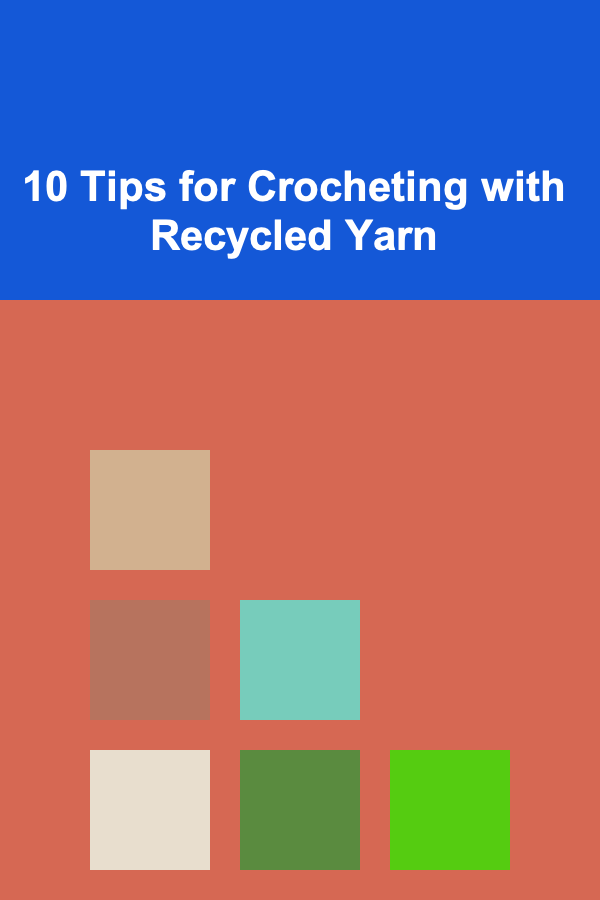
10 Tips for Crocheting with Recycled Yarn
ebook include PDF & Audio bundle (Micro Guide)
$12.99$10.99
Limited Time Offer! Order within the next:

Crocheting with recycled yarn has become an increasingly popular trend, offering a sustainable way to create beautiful, eco-friendly items while reducing waste. Using recycled yarn not only supports environmental efforts but also adds a unique and personal touch to your handmade creations. Whether you are a seasoned crocheter or a beginner, incorporating recycled yarn into your projects can elevate your work and help you make a positive impact on the planet. In this article, we'll explore 10 valuable tips to help you crochet with recycled yarn effectively and confidently.
Understand the Different Types of Recycled Yarn
Before you begin crocheting with recycled yarn, it's essential to understand the various types available. Recycled yarn can come from a range of materials, such as plastic bottles, old t-shirts, leftover fabric scraps, or even discarded garments. Each type of recycled yarn has its own unique characteristics and requires different handling techniques.
Common Types of Recycled Yarn:
- Plastic Bottle Yarn (T-shirt yarn): This type is made from repurposed plastic bottles or old t-shirts, resulting in a thick and sturdy material that's perfect for accessories, home decor, and bags.
- Fabric Scraps Yarn: This is made by shredding fabric from discarded clothing or textile waste, creating a soft yet durable yarn suitable for both light and heavy projects.
- Upcycled Wool: This is yarn made by reprocessing wool from old garments. It's an eco-friendly way to reuse high-quality wool and can be perfect for garments, scarves, or blankets.
- Recycled Cotton Yarn: Often derived from textile waste or unsold clothing, recycled cotton yarn is soft and breathable, ideal for lightweight projects like shawls, tops, and dishcloths.
Once you are familiar with the different types of recycled yarn, choose the one that best fits your project's needs, keeping in mind its texture, durability, and flexibility.
Check the Yarn's Quality Before Starting
Recycled yarn can sometimes be less consistent than yarn made from virgin materials, especially if it's been processed from multiple sources. Before beginning any project, it's important to assess the quality of the yarn to avoid frustration during crocheting.
What to Check:
- Strength and Durability: Gently tug on a small sample of the yarn to check for any signs of weakness or breakage. If the yarn feels fragile or prone to snapping, it may not be suitable for projects that require strong, long-lasting materials.
- Texture and Softness: Examine the yarn for any rough spots or irregularities. You want your yarn to be comfortable to work with and wear, especially if you're creating items that will be worn against the skin.
- Consistency: Roll out a length of yarn and see if it maintains a consistent thickness throughout. If the yarn is uneven, it could affect the appearance of your finished project.
By testing the yarn before starting your project, you can avoid unwanted surprises and ensure a smooth crocheting experience.
Use the Right Hook Size
Recycled yarn can sometimes be bulkier or thinner than traditional yarn, which can affect how the yarn interacts with your crochet hook. Choosing the right hook size for your recycled yarn is crucial for achieving a consistent stitch pattern and a well-proportioned project.
How to Choose the Right Hook:
- Check Yarn Thickness: If the recycled yarn is bulky, opt for a larger hook to accommodate its size and to ensure your stitches are not too tight. Conversely, if the yarn is thinner, select a smaller hook to maintain a tight and neat finish.
- Adjust for Texture: Some recycled yarns, like fabric scraps, can have a textured or rough surface. If you're working with a yarn that feels difficult to handle, try using a larger hook to make it easier to maneuver and avoid tight, uncomfortable stitches.
- Swatch First: Before starting your project, crochet a small swatch with your chosen hook to see how the yarn behaves. This will help you gauge whether the hook size works well for the material.
Selecting the right hook size is key to making the crocheting process easier and ensuring the quality of your final piece.
Be Patient with Tension and Gauge
Recycled yarn, especially if it's made from fabric or upcycled materials, can sometimes behave unpredictably, affecting your tension and gauge. Be patient as you adjust to the yarn's unique characteristics. Your tension may initially be tighter or looser than usual, which could change the overall size and appearance of your project.
Tips to Manage Tension:
- Start with a Loose Tension: If you're unsure about the yarn's behavior, try starting with a looser tension to prevent your project from becoming too tight or stiff. You can always tighten it later if necessary.
- Check Your Gauge: If you are making a project that requires specific measurements, like a garment, check your gauge regularly to ensure you're staying on track. You may need to adjust your hook size or tension as you go.
Being flexible and adjusting to the yarn's quirks will help you maintain control over your project and prevent mistakes from affecting the final result.
Mix and Match Different Recycled Yarns
One of the exciting aspects of crocheting with recycled yarn is the opportunity to mix and match different types of recycled materials. Combining various textures and colors can create unique and eye-catching designs, giving your project a distinctive look.
How to Mix Yarns:
- Experiment with Color: Try blending yarns in different colors to create a patchwork effect or a multicolored pattern. Recycled yarn often comes in unexpected colors, allowing you to create unique combinations.
- Mix Textures: Pair a thicker yarn with a thinner one to create texture contrasts. This can be especially effective for creating interesting surface effects, like in crochet rugs, baskets, or blankets.
- Blend Fibers: Some recycled yarns come in different fiber blends (e.g., cotton and polyester), which can help add variety and richness to your designs.
By mixing different yarns, you can infuse creativity into your projects and make them stand out.
Consider the Stretch and Elasticity of Recycled Yarn
Not all recycled yarns have the same stretch or elasticity, and this factor can influence the final look and fit of your project. Some recycled materials, especially fabric yarn, may have little to no stretch, while others may stretch and lose their shape over time.
How to Handle Elasticity:
- For Non-Stretch Yarns: If the yarn has minimal stretch, be mindful of the fit and sizing of your project. This is particularly important for garments or accessories that need to maintain their shape.
- For Stretchy Yarns: If your yarn is stretchy, consider using a tighter tension to prevent the finished piece from becoming too loose or misshapen. You may also need to add extra support, like a lining or reinforced stitching.
Understanding how the yarn reacts to tension and stretching will help you create items that hold their shape and maintain their function.
Incorporate Creative Techniques and Patterns
When crocheting with recycled yarn, it's a great time to experiment with creative techniques and patterns that highlight the texture and unique qualities of the material. The irregularity of recycled yarn can be used to your advantage, especially when creating more textured or rustic designs.
Techniques to Try:
- Crochet with a Twist: Using recycled fabric yarn, try creating designs that incorporate twisted or braided stitches for a textured, handmade look.
- Lace and Mesh Patterns: With lighter recycled yarns like cotton, you can experiment with lace and openwork patterns. The natural texture of the recycled material can make these designs pop in a unique way.
- Chunky Patterns: For bulkier recycled yarns, try using large stitches and simple patterns like basket weave or granny squares to show off the yarn's texture.
By exploring different techniques and patterns, you can make the most of your recycled yarn and create standout pieces.
Use Recycled Yarn for Eco-Friendly Gifts and Home Decor
Recycled yarn is perfect for creating eco-friendly gifts and home decor items. From blankets and pillows to bags and accessories, the possibilities are endless, and the eco-conscious nature of your projects makes them even more special.
Gift Ideas:
- Reusable Shopping Bags: T-shirt yarn or fabric scraps can make great reusable shopping bags, combining sustainability with functionality.
- Coasters and Placemats: Small crochet projects like coasters or placemats are excellent ways to use recycled yarn. These items are practical, decorative, and make thoughtful gifts.
- Pillows and Throws: Recycled cotton or wool yarn can be used to make cozy blankets and pillows, adding a personal, eco-friendly touch to any home.
Using recycled yarn for gifts and home decor not only helps reduce waste but also creates meaningful, one-of-a-kind items.
Be Mindful of Yarn Sources and Sustainability
While crocheting with recycled yarn is inherently more sustainable than using virgin yarn, it's still important to consider the source of your recycled materials. Look for yarns that are produced in an environmentally friendly way and avoid yarns that use harmful chemicals or practices during processing.
Consider These Factors:
- Eco-Friendly Certifications: Look for recycled yarns that are certified by organizations such as GOTS (Global Organic Textile Standard) or Fair Trade. These certifications ensure that the yarn is produced with minimal environmental impact.
- Packaging: Choose yarn brands that use sustainable, minimal, or recyclable packaging to reduce waste in the production and distribution process.
By being mindful of your yarn's origins, you can ensure that your crocheting is as eco-conscious as possible.
Support Ethical Yarn Brands
One of the most rewarding aspects of crocheting with recycled yarn is knowing that you are supporting businesses that prioritize sustainability and ethical practices. Many small, local yarn producers focus on upcycled materials and sustainable production methods, contributing to a greener future.
How to Support Ethical Brands:
- Research the Brand's Mission: Before purchasing recycled yarn, research the company's mission and values to ensure they align with your ethical standards.
- Shop Small: Support local artisans and small businesses that focus on creating eco-friendly products, as they often produce high-quality yarns with a positive environmental impact.
- Share Your Knowledge: Spread the word about ethical brands and recycled yarn to encourage others to embrace sustainability in their crafting practices.
Supporting ethical yarn brands not only enhances your crocheting experience but also helps foster a sustainable crafting community.
Conclusion
Crocheting with recycled yarn is a rewarding and impactful way to reduce waste while creating beautiful, functional items. By following these 10 tips, you can confidently work with recycled materials and produce stunning projects that are both eco-friendly and unique. With a little patience, creativity, and attention to detail, you can make a meaningful contribution to sustainability while enjoying the art of crochet. Whether you're a beginner or an experienced crocheter, the possibilities with recycled yarn are endless---so dive in, explore, and let your creativity flourish!
Reading More From Our Other Websites
- [Personal Care Tips 101] How to Choose the Best Blush Formula for Your Skin Type
- [Organization Tip 101] How to Use a Pegboard to Maximize Craft Room Space
- [Home Holiday Decoration 101] How to Create a DIY Holiday Advent Calendar for a Fun Countdown
- [Scrapbooking Tip 101] Best Color Theory Tips for Crafting Cohesive Scrapbook Color Schemes
- [Biking 101] Top 5 Common Cycling Injuries and How to Treat Them
- [Digital Decluttering Tip 101] The Ultimate Digital Hygiene Checklist for Remote Workers
- [Organization Tip 101] How to Utilize Wall Space for Hanging Jewelry Creatively
- [Home Maintenance 101] How to Clean and Maintain Your Chimney for Safety and Efficiency
- [Home Storage Solution 101] How to Use Trunks and Chests for Stylish Storage Solutions
- [Home Staging 101] How to Stage a Kitchen for a Functional and Modern Look

How to Build a Sales Funnel that Nurtures Leads and Drives Conversions
Read More
How to Create a Budgeting Checklist for Software Implementation
Read More
How to Keep Your Craft Kits Tidy While Traveling
Read More
How to Plan for Quick Meals When You're Short on Time
Read More
How to Sell Vintage Home Goods on Instagram: An Actionable Guide
Read More
10 Tips for Printing Waterproof Labels at Home
Read MoreOther Products

How to Build a Sales Funnel that Nurtures Leads and Drives Conversions
Read More
How to Create a Budgeting Checklist for Software Implementation
Read More
How to Keep Your Craft Kits Tidy While Traveling
Read More
How to Plan for Quick Meals When You're Short on Time
Read More
How to Sell Vintage Home Goods on Instagram: An Actionable Guide
Read More